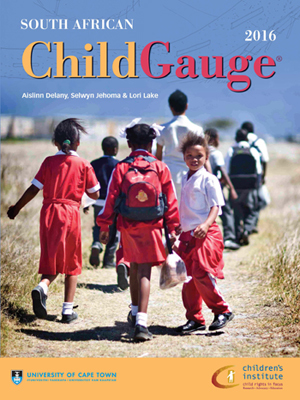Investing in children: Child Gauge 2016
06 December 2016 | Story Pete van der Woude. Photo Michael Hammond.
The 11th annual issue of the South African Child Gauge looks at how the Child Support Grant (CSG) has benefited approximately 12 million South African children. It also reflects on the challenges that remain as the grant matures into what is now a well-established element of social protection policy.
The Child Gauge is the annual publication of UCT's Children's Institute that reports on the progress towards the realisation of children's rights in South Africa.
It is produced in partnership with UNICEF South Africa; the Programme to Support Pro-Poor Policy Development in the national Department of Planning, Monitoring and Evaluation; the DST-NRF Centre for Excellence in Human Development at Wits; and the FNB Fund.
Contributors include academics, activists, members of civil society, government officials and representatives, and representatives from international development organisations.
Benefits of the Child Support Grant
Children are among the hardest hit by poverty, and poor households bear the main responsibility for looking after the greatest number of children. Social assistance provided by the state is therefore indispensable for children, especially during their first two years, the period of their most rapid brain and cognitive growth.
“The CSG is associated with improved nutrition, health and schooling among children,” explains Alejandro Grinspun of UNICEF South Africa. So, for example:
- The CSG enables households to increase spending on food and helps to reduce child hunger and improve child nutrition, with the strongest effects in poorer households.
- The CSG has helped halve the share of children living below the food poverty line (the most severe measure of poverty), from 58% of children in 2003 to 30% in 2014. Children living in extreme poverty have benefitted the most.
- The CSG is associated with improvements in schooling, including enrolment, progression and attainment.
- The CSG has a protective effect in adolescence, and receipt of the CSG during early childhood is associated with reduced alcohol and drug use and delayed sexual debut among teenage girls.
- The CSG also enables caregivers to seek employment by contributing to travel and child care costs.
“Targeting of the CSG has been so effective that its benefits accrue mostly to South Africa's poorest, and it is children living in extreme poverty who have gained the most from it,” notes Grinspun.
With these benefits in mind, the CSG is clearly a crucial investment in children and the future.
Current gaps and challenges
Challenges remain for the system, however, according to Aislinn Delany, lead editor of the Child Gauge 2016. Around 1.8 million eligible children are still not accessing the grant, and many of these are the neediest young children. Key barriers include difficulty in accessing the necessary documents for the grant application.
More critically, at R360 per month (or R12 a day), the Child Support Grant falls below all three of the national poverty lines proposed by Statistics South Africa, including the food poverty line, which is only enough to cover a child's most basic daily food needs.
This means that, despite all its successes, the CSG can only do so much, says Mastoera Sadan of the Programme to Support Pro-poor Policy Development (PSPPD) in the national Department of Planning, Monitoring and Evaluation.
“Its effects on reducing inequality are muted in the short term because of its low cash amount.”
The way forward
It is clear from these challenges that it is necessary not only to consolidate the benefits of the CSG over the past 18 years, but also to maximise its impact. To this end, a number of proposals are currently under consideration. This, says Delany, will assist in realising children's rights to social assistance.
“Any discussion of policy reforms must be underpinned by the constitutional imperative to progressively realise the right to social assistance for children in need.”
Sadan reiterates the central role of the grant as an investment in children and in the country as a whole.
“Given widespread and persistent poverty and inequality in South Africa, the CSG is an investment in the development and potential of children,” she says.
“Together with investments in other services, social grants can build the resilience of children and their families with social and economic benefits to society in the long run.”
The South African Child Gauge 2016 is available online...
 This work is licensed under a Creative Commons Attribution-NoDerivatives 4.0 International License.
This work is licensed under a Creative Commons Attribution-NoDerivatives 4.0 International License.
Please view the republishing articles page for more information.










